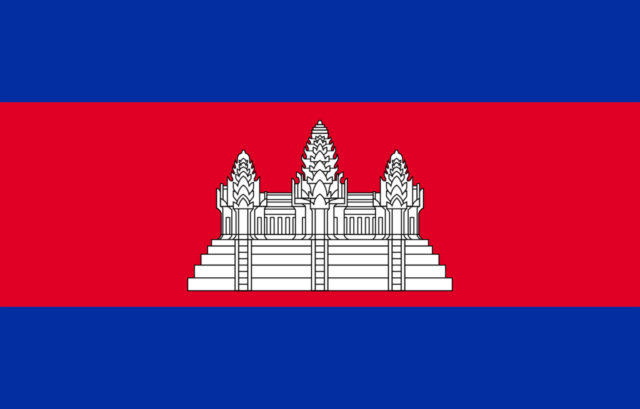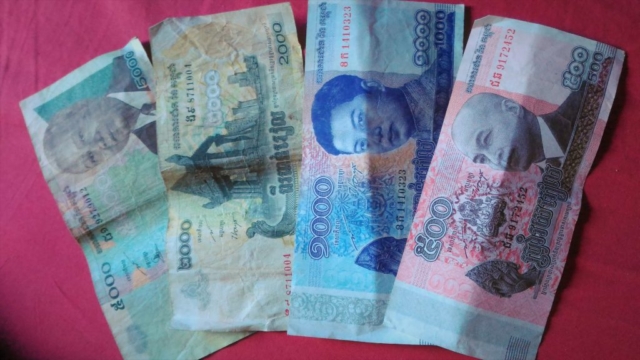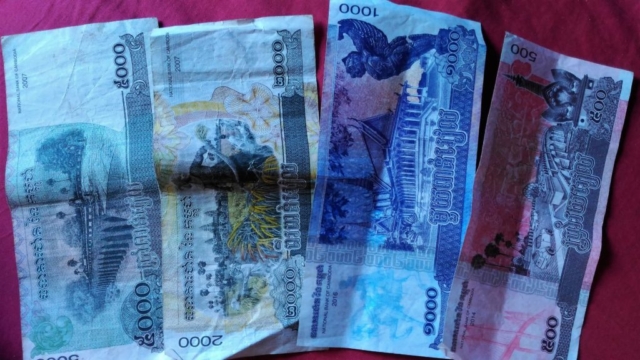Flag
- Since 1850, Angkor Wat has been at the center of the flag
- The current flag with a blue border and red center was adopted after Cambodian independence
- The current Cambodian flag, together with the flag of Afghanistan, Spain, and Portugal, are the only four flags of the state that have a building
- Red and Blue are the traditional colors of Cambodia
The Royal Flag
- It is the personal flag of the Cambodian monarch
- Officially adopted in 1993, but the initial use dates back to 1941
Royal Coat of Arms (Royal Seal)
- It is a symbol of the Cambodian monarchy and the reign of the Cambodian monarch
- The light blue shield is supported by two royal animals
- Gajasingha (lion with the trunk) on the left and Rajasingha (lion) on the right holds two royal umbrellas (one on each side) representing king and queen
- The blue ribbon carries the inscription: Preah Chau Krong Kampuchea (Lord of the Kingdom of Cambodia)
Anthem
- Nokor Reach (Majestic Kingdom)
- It is based on Cambodian folk melodies
It was originally adopted in 1941. In 1970 the monarchy was abolished, replacing the national anthem of the state. Red Khmer replaced it with an anthem (“Famous April 17”). After the royal party defeated the former Communists in the 1993 elections, the royal anthem was restored.
Currency – Cambodian Riel (KHR) and US Dollar (USD)
Banknotes (KHR) – 100, 500, 1000, 2000, 5000, 10 000, 20 000, 50 000, 100 000
Banknotes (USD) – 1, 5, 10, 20, 50, 100
Riels are mostly used for small transactions instead of US coins that are nowhere accepted. Dollarization began in the 1980s and continued until the early 1990s when the United Nations contributed to humanitarian aid. Make sure the banknotes are not damaged.
Many banks also refuse $ 2 banknotes. Banknotes valued at $ 50 and $ 100 are usually carefully reviewed before they are accepted. Sometimes trader takes the banknote, goes away, comes back and gives you the banknote. Unfortunately, he will probably return the counterfeit!
The Cambodian central bank maintains a rate of about 3,800 to 4,200 KHRs per USD 1, but in general, you will meet a fixed exchange rate of 4,000 KHR = 1 USD. If you have any riels, replace them before you leave Cambodia, because it is the only place where you can change it. Or you can save them as a souvenir.
ATMs
ATMs are expanding, but do not count on the islands and villages with them. Cambodian ATMs are generally compatible with Maestro, Cirrus, Plus and VISA cards. Most ATMs only issue US dollars in different denominations from $ 10 to $ 100. The $ 150 limit is for cards with the Maestro and MasterCard logo, VISA cards have a $ 1000 limit.
Travel checks
Traveler’s checks, such as credit cards, are accepted in large business facilities such as large hotels, some restaurants, travel agencies, and some souvenir shops. American Express (USD) is the most accepted.
Example of prices
Baguette: 2000 KHR
Refill the water from barrel: 2000 KHR
1 piece of melon / pineapple / papaya: 2-3 USD
Fresh coconut: 1.5 USD
Cookies and biscuits (imports): 2-5 USD
Fruit shake: 1-3 USD
Rice or noodles with vegetables and chicken: 2,5 – 3,5 USD
Amok with chicken and rice: 3.5 – 5 USD
Filled baguette: 2.5 USD
Soft drink (330 ml): 1 – 3 USD
Homemade cookies (4pcs): 2.5 USD
Magnum ice cream: 2.5 USD
Ship ticket: USD 12 per person
Bus ticket from Phnom Penh to Sihanoukville: USD 14 per person
Bus ticket from Siem Reap to Phnom Penh: USD 16 per person
Taxi from Sihanoukville Airport to Sihanoukville: 20 USD
One-day Angkor Wat entry: USD 37 / person
Tuol Sleng entrance: USD 5 / person
Sim card: 2.5 USD
Credit for the week of the 6GB Internet: 1 USD
1 kg washing laundry: 1 USD
Rent a bike for 1 day/person: 4 USD


